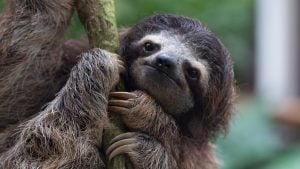

A heartwarming video of a nature photographer helping a baby sloth reunite with its mother has gone viral on social media. It shows the photographer picking up the baby sloth, which had fallen out of a tree. He returned it to its mother, which extended her arm to “thank” the photographer. The video has racked up millions of views so far on different platforms, but not everyone is convinced that this was a friendly gesture from the animal.
[Related reading: Rocket launch broadcast photobombed by the cutest sloth]
The video went viral, and it’s been shared on Reddit, Instagram, YouTube, X, and Facebook. We don’t know who the original poster is, but we do know that it’s in Portuguese. As I mentioned, the video shows the photographer reuniting the baby sloth with its mom. As the mother sloth wrapped her arm around her baby in a show of affection, the photographer raised his camera to capture the moment.
But the video then gets an even more emotional turn. It shows the mother sloth extending her arm to the photographer, which he gently shakes before waving goodbye.
Is the sloth really saying “thank you”?
According to some Redditors, the sloth mom wasn’t actually trying to thank the photographer. As a matter of fact, she actually wasn’t happy with him touching her baby at all! ” I work at a sanctuary that has a few two-toed sloths,” one Reddit user wrote. “This is exactly what they do when they want to bite you.”
“Anthropomorphism… ‘Oh look it wants to thank me!’” another person wrote. “Meanwhile the animal wants to slaughter you.” Let’s stay here and expand on anthropomorphism a bit. I personally find this topic very interesting, and I hope you will as well.
Anthropomorphism is a cognitive bias that makes us perceive and interpret the world around us in terms of human intentionality. In other words, it makes us see human-like qualities in non-human things, such as animals, objects, and natural phenomena.
There are many reasons why we anthropomorphize. First, it helps us make sense of the world around us. Then, it can be a way of connecting with and empathizing with other animals. Finally, it can also be a form of entertainment: just think of all the anthropomorphic characters in movies, cartoons, and video games.
Here are some examples of anthropomorphism:
Saying that a dog is “smiling” when it is showing its teeth
Thinking that a cat is “mourning” for a dead owner
Dressing up a pet in human clothes
Attributing human emotions to wild animals, such as saying that a bear is “angry” or a wolf is “sad”
Talking about natural phenomena as if they were human beings, such as saying that “the sun is smiling” or “the wind is angry”
While anthropomorphism can be harmless and even beneficial for our interaction with the world, it also has some pitfalls. For example, anthropomorphizing animals can lead to unrealistic expectations and misunderstandings about their behavior, as apparently was the case with this video. Additionally, anthropomorphizing objects can lead to losing respect for the natural world.
So, the next time you see a cute wild animal “smiling” or “waving” at you or whatever, have this in mind and keep your distance – for both your safety and theirs.
[via PetaPixel]







